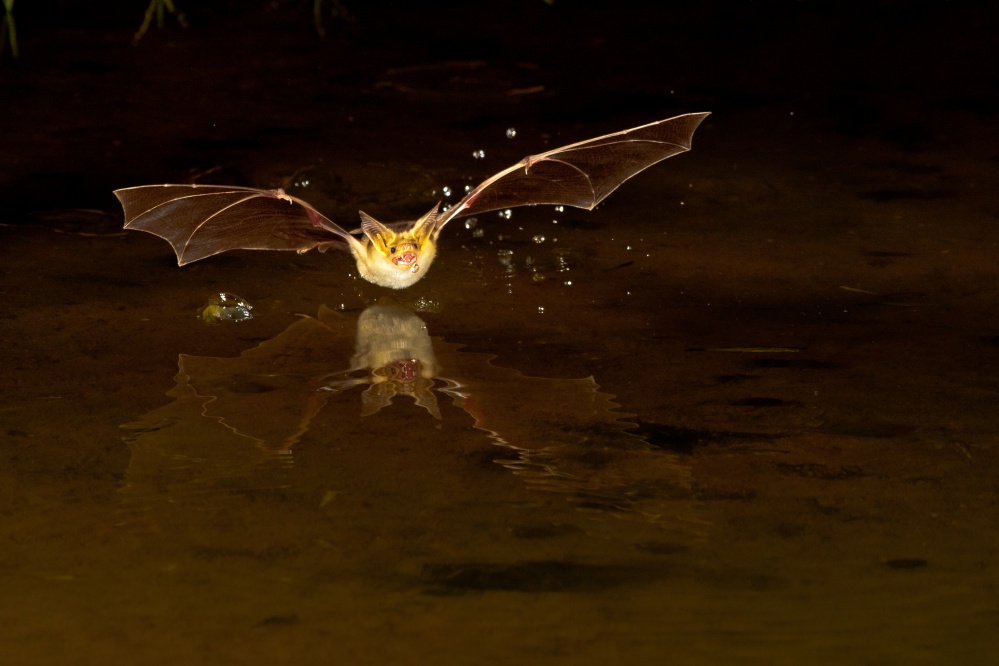Where to See Bats and Why We Should Protect Them

We learn about the National Bat Monitoring Programme and find out how we can get involved
Ian Bond is a citizen scientist who contributes to the National Bat Monitoring Programme. That means he tries to encourage other people to get involved with monitoring bats in our area. ‘While few people would claim that animals should have the same rights as people, it seems reasonable that we should give them some consideration and protection when we have so much in common,’ he explains. ‘For many people there is a growing awareness about how we are losing a lot of the world’s wildlife. While only a small proportion of species are completely extinct, an awful lot more are all but gone and realistically it won’t be possible to save all of them. Therefore it is vital that we save what we can.’
But, compared to the other animals, bats are a little misunderstood. ‘That’s quite understandable really, given that they only come out at night and fly harum-scarum so that you struggle to follow them,’ Ian says. ‘So most of us never get the chance to have a good look at them close up. Even if they do, they do look a lot like mice. In other countries they are even called mice; the Germans call them “flying mice” and the French call them “bald mice”. In reality though, they aren’t mice at all and don’t do any “mousey” things. In fact if we look at the way mammals evolved from their early forms, bats came from the same stock as horses, dogs, hedgehogs and whales.
‘Bats have an air of mystery, and for me that’s part of their attraction. Bats are familiar to us, but at the same time very different to any other animal, and there is always a thrill as one flashes through our field of view then out into the darkness.’
Their ability to fly long distances means they play a key role in ecosystems too. They’re essential pollinators for many plants and also spread the seeds of plants over large distances, creating new habitats. However, while bats are popular at Halloween, unfortunately Halloween isn’t popular with bats. ‘I am often asked to lead bat walks for Halloween events, only to have to tell the event organiser that unless it’s an unseasonably warm October, the bats will all be hibernating. Fortunately, bats retain people’s fascination for the rest of the year and bats walks in the summer are nearly always packed out.’
In Britain, as all of our bat species eat insects, they are fairly high in the food chain and can be an indicator of the health of the environment. ‘Bats only have one young each year so if anything were to happen to a population of them, it could take many years for them to recover their numbers,’ Ian says. ‘Some species of bat are starting to increase in numbers due to better protection and specific conservation measures but they will always be very vulnerable because of their specialist requirements and low birth rate.
‘The great thing about the monitoring programme is that there are several different types of survey that cater for all levels of experience. For the sunset survey the only knowledge you need is to know a bat when you see one, as it just involves being out in your garden or local park for an hour at sunset and noting down whether or not you saw a bat. You don’t even have to be able to identify which type of bat it is. The roost survey is only slightly more complicated in that it involves counting the number of bats that emerge from a building. If that building is your own house then a deck chair and a glass of wine are all the equipment you need. You will need to know what type of bats they are but there is usually someone from the local bat group who would be only too happy to help you identify them.’
But just how many bats can we expect to find in Yorkshire and the North East – and where? ‘A very few locations, such as Fountains Abbey in Yorkshire and Brinkburn Priory in Northumberland have been monitored for a few decades now, so there is long term information on the numbers of bats that roost there,’ Ian says, but he admits they need a lot more data from the wider region. ‘Volunteers for the Bat Conservation Trust have gathered enough data to work out the population trend for 11 of the UK’s 17 bat species across the country as a whole, but we need more locations in our region to be surveyed to give them enough information to work out the local picture.’
It’s clear there’s still plenty to discover about bats here, which we find out when Ian reveals that we don’t even know for sure how many different species we have in Yorkshire and the North East. ‘As far as we know, Yorkshire is leading the bat species count 11 to 9 but earlier this year a friend of mine saw what he was sure was one of the two Yorkshire species along the Tees, which means they may be moving into the North East,’ Ian says. ‘Up until the 1940s, Yorkshire had another two species of bat as well; hopefully conservation efforts will result in them recolonising the county one day.’
So where can we see them? Ian’s answer is: everywhere. ‘There is probably nowhere in our region that doesn’t have a bat flying over it at some time or another,’ he reveals. ‘But the areas supporting the most bats will be the middle reaches of the rivers, particularly where these are surrounded by woodland. Even in the middle of towns you will get bats, but almost always the bats in heavily urbanised areas, at least “up North”, will just be the Common Pipistrelle, which tolerates lighting a bit better than most bat species do.’
FUN FACTS
- Their knees are on back to front, which helps when they are hanging upside down.
- A bat’s wing is actually its hand; they just have incredibly long fingers with the skin stretched between them.
- A bat’s call is as loud as a pneumatic drill; the reason they don’t deafen themselves is that their ear bones separate every time they call and then close again in time for them to hear the echo come back. They can do this dozens of times a second. The reason that they don’t deafen us is that their calls are too high pitched.
- The smallest bat in the world is the Bumblebee bat; it would take about 12 of them to weigh the same as a standard packet of crisps.
- The call of a Pipistrelle, when heard through a tuneable bat detector, could be described as sounding like someone puffing out their cheeks and hitting them.
Click here to find out more about the National Bat Monitoring Programme and how you can get involved locally.







